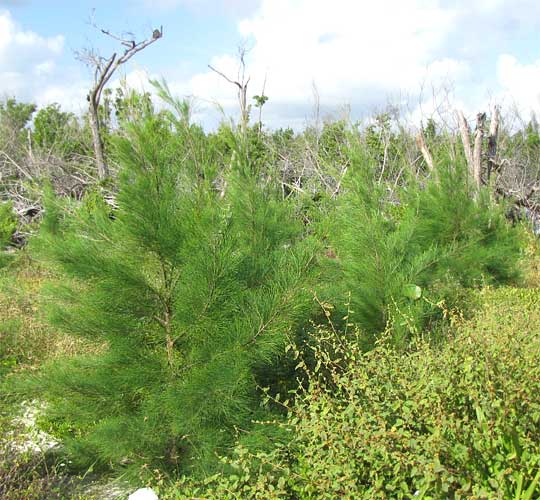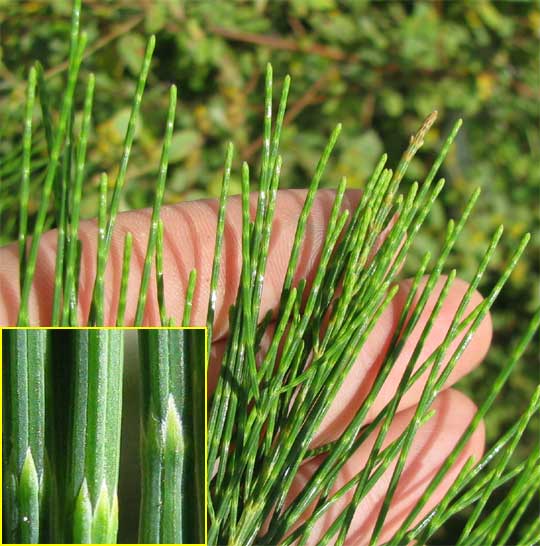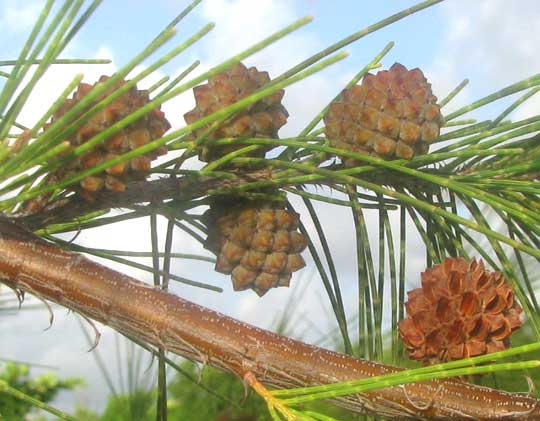Excerpts from Jim Conrad's
Naturalist Newsletter
from the December 22, 2008 Newsletter issued from Mayan Beach Garden Inn 20 kms north of Mahahual; Caribbean coastal beach and mangroves, ~N18.89°, ~W87.64°, Quintana Roo state, MÉXICO
AUSTRALIAN PINE CHRISTMAS TREE
This week I drew the chore of going out to cut a Christmas tree to be set up in the hotel's reception room. Normally I don't cut wild trees for Christmas service, but this time when I set off down the narrow sand road carrying a bucksaw I actually felt pretty good about it.
For, the obvious candidate for Christmas-tree service around here is what's shown vigorously growing on the dry sand ridge next to Hurrican-Dean-savaged mangrove below:

That looks a lot like Loblolly Pine back in Mississippi and one of its English names is Australian Pine, but its similarity to any pine tree is purely incidental. It's CASUARINA EQUISETIFOLIA, a member of what could be called the Australian Pine Family, the Casuarinaceae. Pines are gymnosperms but Australian Pines are flower-producing angiosperms. On the phylogenetic Tree of Life this family stands close to oaks, birches, walnuts and beeches.
If you look closely at an Australian Pine's "needles" you see that they're not like pine needles at all, as shown below:

What appears to be Australian Pine's "needles" are actually slender, much-branched, green to grey-green, toothpick-wide stems bearing minute scale-leaves in whorls of 6–8. Remembering that the leaves are tiny, scale-like things in whorls of 6-8, you can figure out where they are in the close-up shown in the inset at the picture's lower left.
I didn't feel too bad about cutting an Australian Pine because it's a serious invasive here and through much of the world, and the species is highly "allelopathic" -- it produces chemicals that inhibit the growth of other species. Once Australian Pine gets established it tends to form pure stands with few other plants able to survive near them, and offering relatively little food and shelter to wildlife. Dense stands of Australian Pine look lush and green, but ecologically they are deserts.
Therefore, Australian Pine is listed as a Category I invasive exotic species by the Florida Exotic Pest Plant Council. Possession, collection, transportation, cultivation and importation of Australian Pine are prohibited by the Florida Department of Environmental Protection.
On the other hand, Australian Pine is very tolerant to sand, sun and salt spray, stabilizes sandy, windblown soil, and grows quickly producing firewood in places where few other tree species can grow. I've seen it referred to as "the best firewood in the world."
I'm told that around the hotel there were no Australian Pines before Hurricane Dean, but now I see that they're abundant all up and down this sandy beach. Efforts have been made to remove them from the Sian Ka'an Biosphere Reserve just to our north.
From what I can see, those efforts are doomed to fail.
from the August 21, 2011 Newsletter issued from Mayan Beach Garden Inn 20 kms north of Mahahual; Caribbean coastal beach and mangroves, ~N18.89°, ~W87.64°, Quintana Roo state, MÉXICO
AUSTRALIAN PINES DROPPING SEEDS
The trees shown in the above entry, about six feet tall there in 2008, now are about 20 feet tall. Nowadays their cones are releasing seeds onto the ground. You can see a cluster of cherry-sized cones below:

A cone with three papery-winged seeds below it is shown below:

Though Australian Pines aren't pines -- aren't members of the genus Pinus, but rather Casuarina -- it's proper to call Australian Pine fruits "cones." They're cones because they are, along with pines, gymnosperms. Still, Australian Pine cones differ from cones of real pines in that their seeds do not fall from beneath woody, overlapping scales, but rather from what look like little turtle heads that spit out the seeds. You can compare our Australian Pine cone with a big, fragrant "real" cone of Jeffrey Pine in Oregon at www.backyardnature.net/n/09/090426jq.jpg.